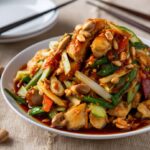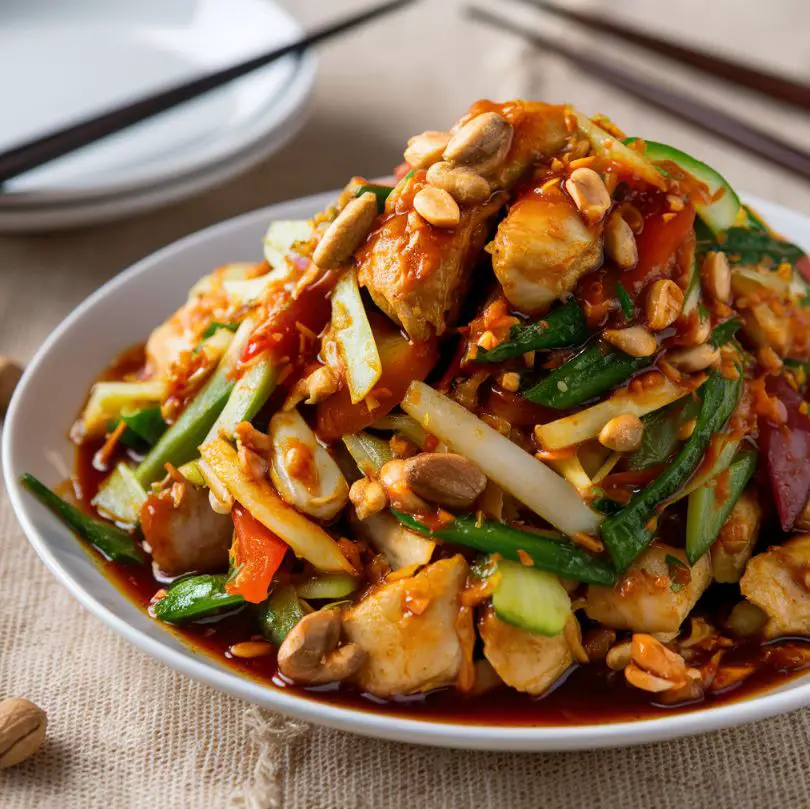Introduction to Kung Pao Chicken
Kung Pao Chicken is a quintessential Chinese dish that has captured the hearts of food enthusiasts around the globe. Hailing from the rich culinary traditions of Sichuan province, this iconic recipe is renowned for its harmonious blend of sweet, savory, and spicy flavors. At its core, Kung Pao Chicken features tender morsels of chicken, roasted peanuts, and a medley of vegetables, all enveloped in a distinctive, mouth-watering sauce.
The origins of Kung Pao Chicken trace back to the Qing Dynasty, where it was named after Ding Baozhen, a governor of Sichuan province. Ding Baozhen, also known as « Kung Pao » (宮保), was a well-respected figure, and over time, his name became synonymous with this delicious dish. Traditionally, Kung Pao Chicken is characterized by the use of Sichuan peppercorns, which bestow a unique, numbing spiciness, coupled with dried red chilies that add a fiery kick. The intricate balance of these components ensures that each bite is a flavorful adventure.
While Kung Pao Chicken may seem like an exotic and complex dish, it is surprisingly accessible for home cooks. With readily available ingredients and straightforward cooking techniques, even novice chefs can recreate this classic dish with ease. This makes it a perfect addition to your culinary repertoire, whether you’re cooking for a casual weeknight dinner or an elegant dinner party.
Through this simple recipe, you will learn how to bring the taste of authentic Kung Pao Chicken into your own kitchen, delighting your senses and impressing your guests. So, gather your ingredients and hone your cooking skills, as you embark on a culinary journey to master the art of Kung Pao Chicken.
Ingredients Required
To make authentic Kung Pao Chicken at home, it is essential to gather and prepare the specific ingredients that embody the dish’s rich and complex flavors. For this recipe, we will break down the ingredients into three main categories: marinade, sauce, and the main dish components.
Marinade Ingredients
- Chicken Breast or Thighs: 500 grams, cut into bite-sized pieces. Chicken thighs are recommended for their juiciness, but breasts can be used as a healthier alternative.
- Soy Sauce: 2 tablespoons – use light soy sauce for a balanced umami flavor. Tamari can be substituted for a gluten-free option.
- Shaoxing Wine: 1 tablespoon – this Chinese cooking wine adds depth to the flavor. Dry sherry or rice vinegar can be used as substitutes.
- Cornstarch: 1 tablespoon – helps to tenderize the chicken and gives it a smooth texture.
Sauce Ingredients
- Light Soy Sauce: 2 tablespoons – for seasoning and umami. Low-sodium soy sauce can be used if preferred.
- Dark Soy Sauce: 1 tablespoon – adds color and a deeper flavor. If unavailable, increase the amount of light soy sauce.
- Rice Vinegar: 1 tablespoon – provides a hint of tanginess. Apple cider vinegar can be an alternative.
- Sugar: 1 tablespoon – balances the savory and sour elements.
- Chicken Broth: 3 tablespoons – enhances the sauce’s richness. Water mixed with bouillon can be used if chicken broth is unavailable.
- Chili Paste: 1 teaspoon – for heat. Adjust to personal spice tolerance; Sriracha or another hot sauce can be used.
Main Dish Ingredients
- Vegetable Oil: 2 tablespoons – for stir-frying. Peanut oil or canola oil are good choices due to their high smoke points.
- Dried Red Chilies: 6-8 pieces – adds a smokey heat. Adjust the quantity based on desired spiciness.
- Garlic: 3 cloves, minced – provides a pungent aroma and flavor.
- Ginger: 1-inch piece, grated – adds freshness and a slight zing.
- Scallions: 4 stems, chopped – brings a mild onion flavor and color.
- Roasted Peanuts: 1/2 cup – for crunch and nuttiness. Cashews can be substituted if needed.
Each ingredient plays a pivotal role in creating the authentic taste and texture that define Kung Pao Chicken. The marriage of marinated chicken, a well-balanced sauce, and carefully chosen main dish components yields a harmonious dish that delights the palate with every bite.
Preparation Instructions
Preparing the ingredients meticulously is crucial to crafting an authentic Kung Pao Chicken. Ensuring that all necessary steps are carried out with precision will elevate the dish significantly.
Begin by cutting the chicken breasts into small, bite-sized pieces. Uniformity in size ensures even cooking and better texture. Once cut, transfer the chicken into a bowl and marinate it using a mixture of soy sauce, cornstarch, and Shaoxing wine. This marinade will tenderize the meat while infusing it with essential flavors. Allow the chicken to marinate for at least 30 minutes. This step can be done a day ahead to streamline your cooking process.
Next, prepare the vegetables. Dice the green bell peppers and onion into similarly sized pieces to maintain consistent texture throughout each bite. Mince garlic cloves and grate fresh ginger, ensuring these aromatics are ready to infuse the stir-fry with depth. Additionally, dry roast peanuts until they are golden brown and set them aside for a nutty crunch that characterizes Kung Pao Chicken.
For the sauce mixture, combine soy sauce, dark soy sauce, vinegar, and sugar in a bowl. This combination provides a balanced sweetness with a tangy and savory background. To thicken the sauce, mix in cornstarch dissolved in water. Ensuring all these ingredients are pre-measured and mixed will allow your culinary process to flow seamlessly.
Preparing the dried red chilies is another vital step. These should be cut into 1-inch pieces. Removing the seeds can adjust the spice level to your preference. Toasting them in the oil right before adding the marinated chicken can release their natural oils and heighten the flavor profile of your dish.
Adopting these efficient preparation steps will not only save you time but also enhance the final quality of your Kung Pao Chicken, making it a memorable home-cooked experience.
Cooking Steps
To begin crafting authentic Kung Pao Chicken at home, the process starts with heating the wok. Due to its unique ability to retain high temperatures, a wok is preferred for optimal texture and flavor. Begin by setting the stove to high heat and allowing the wok to preheat until it is almost smoking. This step is crucial as it ensures rapid cooking, essential for achieving the perfect stir-fry.
Once the wok is adequately heated, add a tablespoon of oil and swirl it around the surface. Quickly introduce the marinated chicken pieces, spreading them out to ensure even cooking. Stir-fry the chicken for about 3-4 minutes, or until it turns golden brown on the outside while remaining slightly tender inside. Remove the chicken from the wok and set it aside.
Next, add another tablespoon of oil to the wok. Introduce the garlic, ginger, and dried red chilies, stirring them for about 30 seconds to release their aromatic flavors. Following this, add the diced bell peppers and zucchini, continuing to stir-fry for an additional 2-3 minutes. The vegetables should maintain a slight crunch, contributing to the dish’s overall texture.
At this stage, return the chicken to the wok, combining it with the vegetables. Pour in the sauce mixture, stirring constantly to coat the ingredients evenly. Allow the sauce to thicken slightly, which should take about 1-2 minutes. Incorporate the roasted peanuts and green onions, giving the dish a final stir.
The last critical technique involves balancing the sauce’s consistency. It should be thick enough to cling to the chicken and vegetables without becoming overly sticky. Adjust seasoning with a dash of soy sauce or a sprinkle of sugar if necessary, ensuring a harmonious blend of sweet, spicy, and savory notes.
Tips for Perfect Kung Pao Chicken
Making authentic Kung Pao Chicken at home can be an incredibly rewarding experience, offering both the satisfaction of creating a flavorful dish and the enjoyment of rich, balanced tastes. Achieving the perfect Kung Pao Chicken hinges on a few critical elements: balance of flavors, texture, and ingredient selection.
Foremost, the balance of flavors is essential. Kung Pao Chicken is celebrated for its harmonious blend of savory, sweet, and spicy notes. To attain this balance, ensure your sauce includes soy sauce for umami, sugar for sweetness, and Chinese black vinegar for a touch of acidity. Incorporating Sichuan peppercorns is key to delivering the characteristic numbing spiciness. Adjusting these elements to your personal taste can help you craft a dish that pleases your palate.
Next, maintaining the crunchiness of the peanuts and vegetables is crucial. Toasting peanuts over low heat until golden brown enhances their crunch and flavor. Selecting fresh vegetables such as bell peppers and celery, and stir-frying them for a short duration on high heat, helps retain their crisp texture. Overcooking can lead to soggy vegetables, detracting from the desired contrast in textures.
When it comes to the chicken, thigh meat is preferred over breast meat due to its juicier and more tender nature. Cut the chicken into uniform bite-sized pieces to ensure even cooking. Marinating the chicken in a mixture of soy sauce, cornstarch, and a bit of rice wine imparts flavor while keeping the meat moist and tender during the cooking process.
Avoiding common mistakes can further elevate your Kung Pao Chicken. Ensuring your wok or skillet is sufficiently hot before adding ingredients helps achieve a seared exterior while maintaining juiciness inside. Also, layering the addition of ingredients—starting with aromatics like ginger, garlic, and dried red chilies—ensures that each component contributes to the overall depth of flavor.
For dietary needs or personal preferences, variations of the recipe are easily adaptable. Substitute tofu for chicken to create a vegetarian version, or use cashews instead of peanuts for a slightly different crunch. Experimenting with different vegetables can also add unique twists while catering to dietary restrictions.
Serving Suggestions
When it comes to serving your homemade Kung Pao Chicken, traditional and modern approaches can both elevate your dining experience. A classic way to enjoy Kung Pao Chicken is by pairing it with a bowl of steamed rice. The fluffy, neutral flavor of the rice perfectly complements the bold, savory notes of the dish, creating a harmonious meal. Alternatively, you may opt for a bowl of freshly cooked noodles. Egg noodles or rice noodles can add a different texture and absorb the flavorful sauce beautifully.
Including a side of vegetables is another excellent way to round out your meal. Steamed or stir-fried vegetables such as broccoli, bok choy, or snap peas not only add nutritional value but also provide a delightful contrast in both texture and flavor. A colorful medley of vegetables can enhance both the visual appeal and complexity of your plate. As for garnishes, sliced green onions or a sprinkle of sesame seeds can take your Kung Pao Chicken to the next level. These additions not only add a pop of color but also a fresh, aromatic finish that enriches the overall dish.
For those seeking to add a touch of modernity, consider serving Kung Pao Chicken in lettuce wraps or accompanied by quinoa for a contemporary twist. Lettuce wraps can provide a crisp, refreshing bite, while quinoa offers a hearty, nutritious alternative to traditional sides.
To complement the rich and spicy flavors of Kung Pao Chicken, consider pairing it with a light, refreshing beverage. Green tea, jasmine tea, or a crisp white wine such as Riesling can cleanse the palate and enhance your dining experience. For dessert, a light and mildly sweet option like mango sorbet or a platter of fresh fruit will balance the meal without overwhelming your taste buds.
Whether you lean towards traditional pairings or are open to modern twists, these serving suggestions are designed to help you create a well-rounded, memorable dining experience centered around your delightful homemade Kung Pao Chicken.
FAQs About Kung Pao Chicken
When attempting to make authentic Kung Pao Chicken at home, several common questions arise around ingredients, dietary adjustments, and preparation techniques. Below, we address some of the frequently asked questions to help you master this beloved Chinese dish.
What are Some Alternative Ingredients for Dietary Preferences?
Kung Pao Chicken can be easily modified to accommodate various dietary needs. For a gluten-free version, replace soy sauce with tamari or coconut aminos. For those avoiding refined sugars, substitute sugar with honey or maple syrup. Additionally, for a low-sodium diet, opt for low-sodium soy sauce and reduce the amount of salt in the recipe.
How Can I Adjust the Spiciness Level of Kung Pao Chicken?
The spiciness of Kung Pao Chicken is typically achieved through the use of dried red chilies. To adjust the heat, vary the number of chilies used or remove the seeds, which contain most of the capsaicin. For a milder taste, you can also replace some or all of the dried chilies with bell peppers. Conversely, for a spicier dish, add a pinch of cayenne pepper or chili flakes.
What Are the Best Storage and Reheating Methods?
Proper storage and reheating ensure that the flavors and textures of Kung Pao Chicken remain intact. Store leftovers in an airtight container in the refrigerator for up to three days. When reheating, it’s best to use a stovetop method to preserve the dish’s crispy texture. Heat a little oil in a pan over medium heat and stir the chicken until warmed through. Microwave reheating is also an option, though it may result in a softer texture.
Can I Make a Vegetarian Version of Kung Pao Chicken?
Yes, Kung Pao Chicken can be adapted to a vegetarian diet. Substitute chicken with tofu, tempeh, or a medley of mixed vegetables like zucchini, bell pepper, and mushrooms. Ensure the tofu is extra firm and press it to remove excess moisture for best results. The sauce remains the same, just be sure to use vegetarian-friendly alternatives for any non-vegetarian ingredients.
By addressing these frequently asked questions, we hope to assist you in creating a delicious and personalized version of Kung Pao Chicken at home. Whether adjusting for dietary needs, managing spice levels, or ensuring proper storage, these tips cover the essentials for an authentic culinary experience.
Conclusion and Final Thoughts
Making authentic Kung Pao Chicken at home is not only straightforward but also rewarding, bringing the delightful flavors of this classic dish right into your kitchen. This recipe allows food enthusiasts to experience the tangy, sweet, and spicy sensations that make Kung Pao Chicken a favorite in Chinese cuisine. By following the simple steps outlined, anyone can recreate this flavorful and aromatic dish without the need for specialized equipment or advanced culinary skills.
Kung Pao Chicken’s versatility makes it perfect for various occasions, whether it’s a casual weeknight dinner or a special meal with friends and family. The ingredients are easily accessible, and the preparation process is enjoyable, allowing room for personal touches and experimentation. This dish holds a special place in the culinary world thanks to its rich history and enduring appeal, making it a timeless addition to any recipe collection.
We encourage you to try this recipe at home and delight in the satisfaction of creating a restaurant-quality dish. Share your results with friends, family, and us – we would love to hear about your experience and any variations you might have tried. Join our community by leaving comments below, where you can exchange tips and feedback with other cooking enthusiasts.
Don’t forget to share this post if you found it helpful, and explore the other delicious recipes available on our blog. Each recipe is crafted with care and precision, aimed at bringing the joy of cooking into your home. Your journey to making delectable dishes is just beginning, and we’re here to guide you every step of the way.
Print
How to Make Authentic Kung Pao Chicken at Home: A Simple Recipe
Description
Spicy Kung Pao Chicken!
Tender chicken, crunchy peanuts, and veggies in a bold, tangy sauce—an irresistible stir-fry classic!

